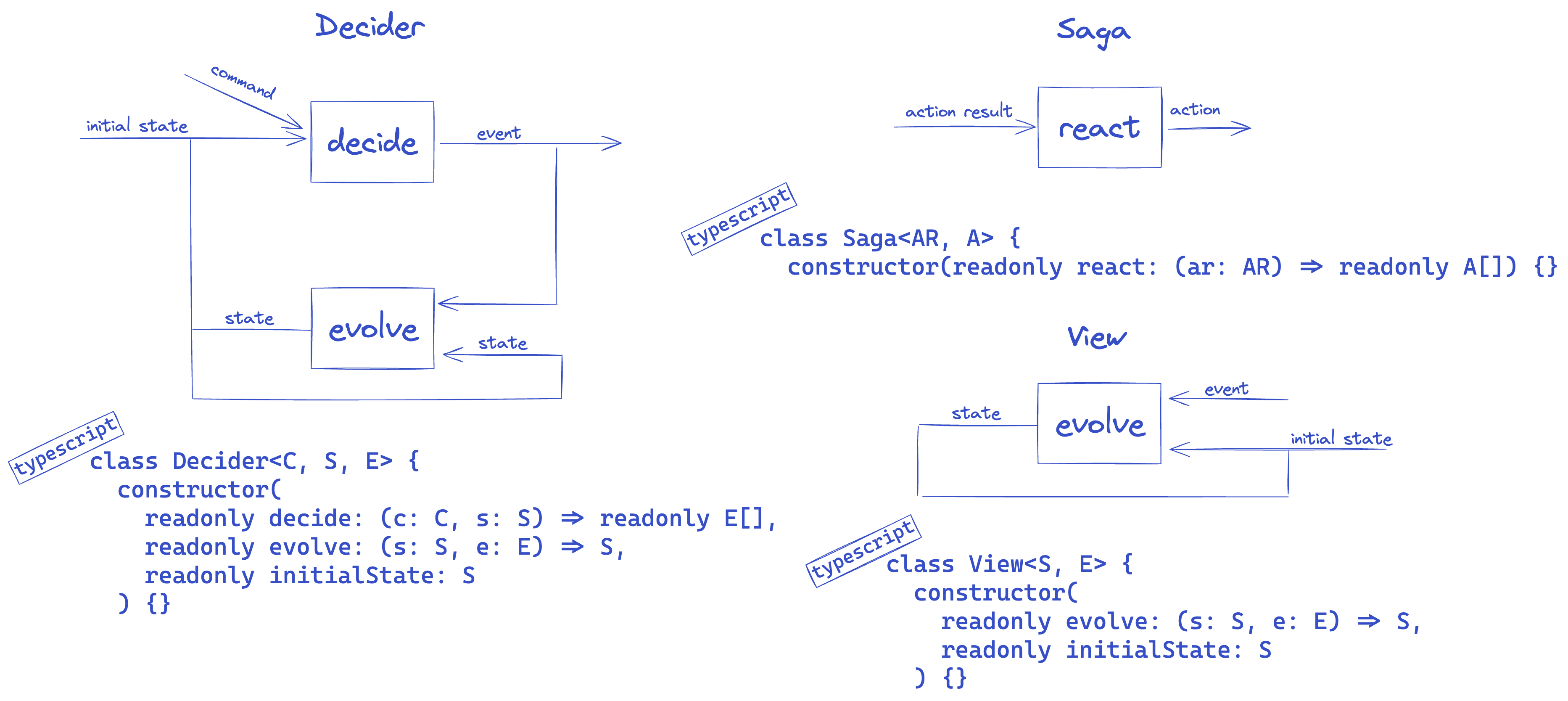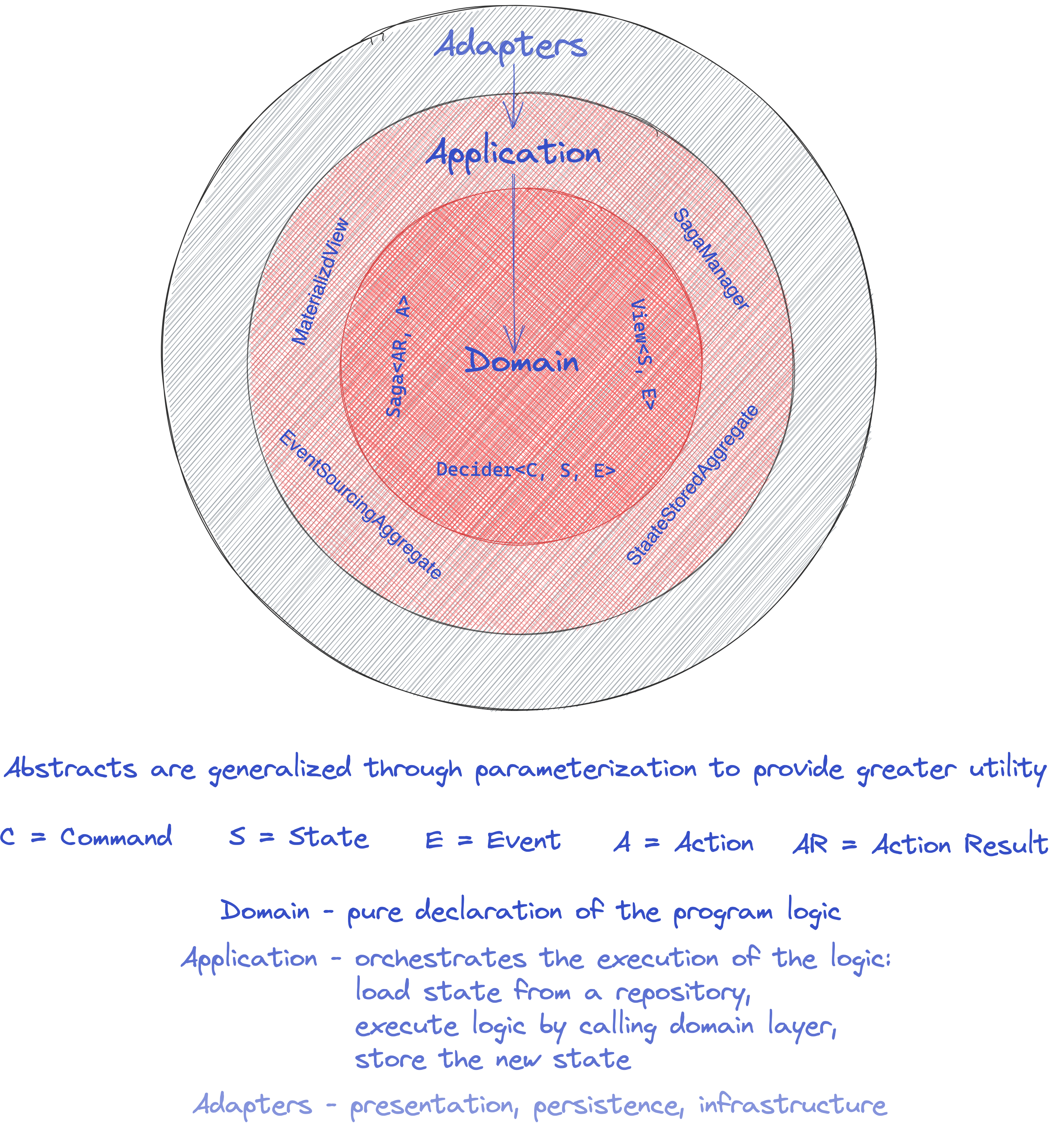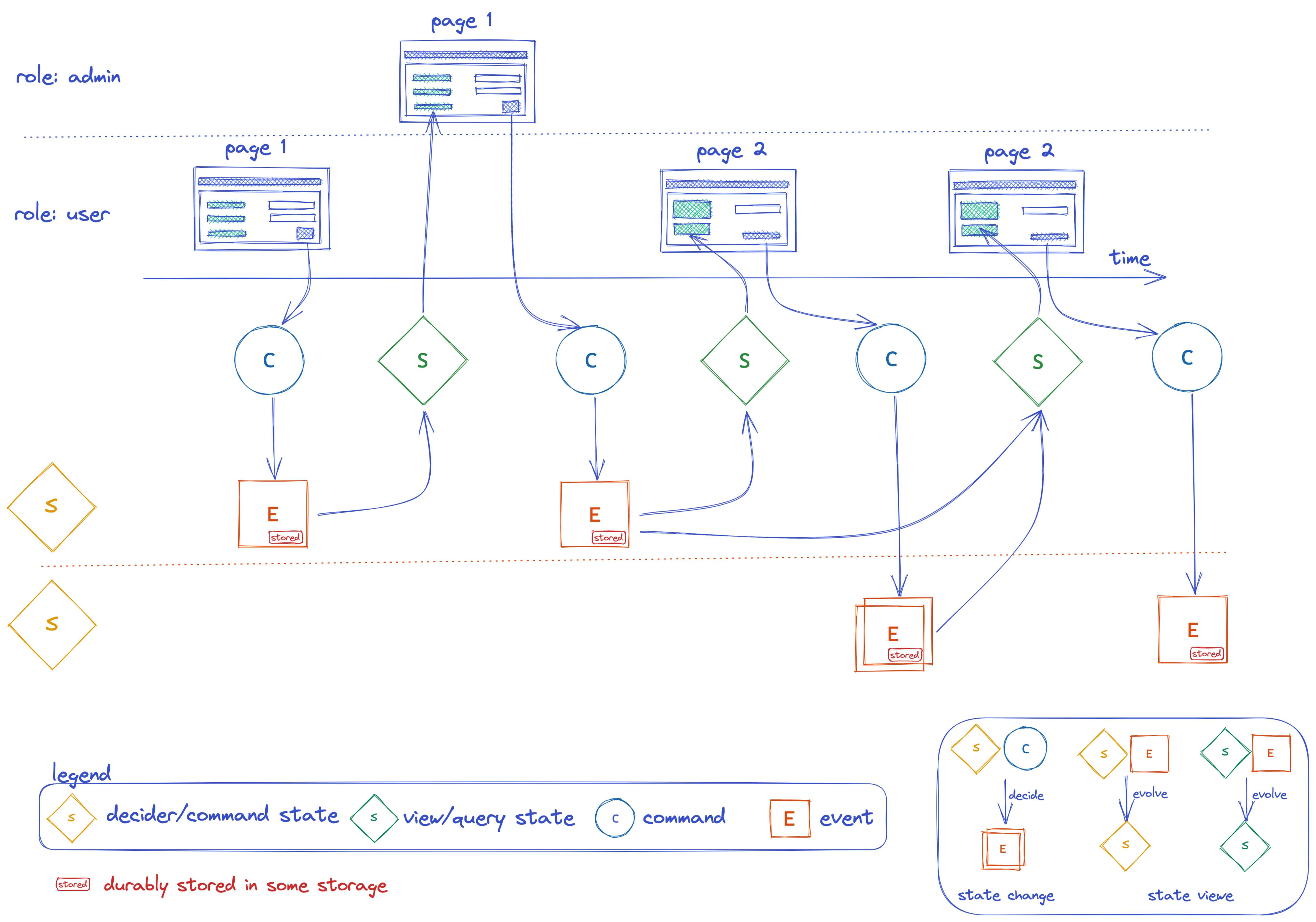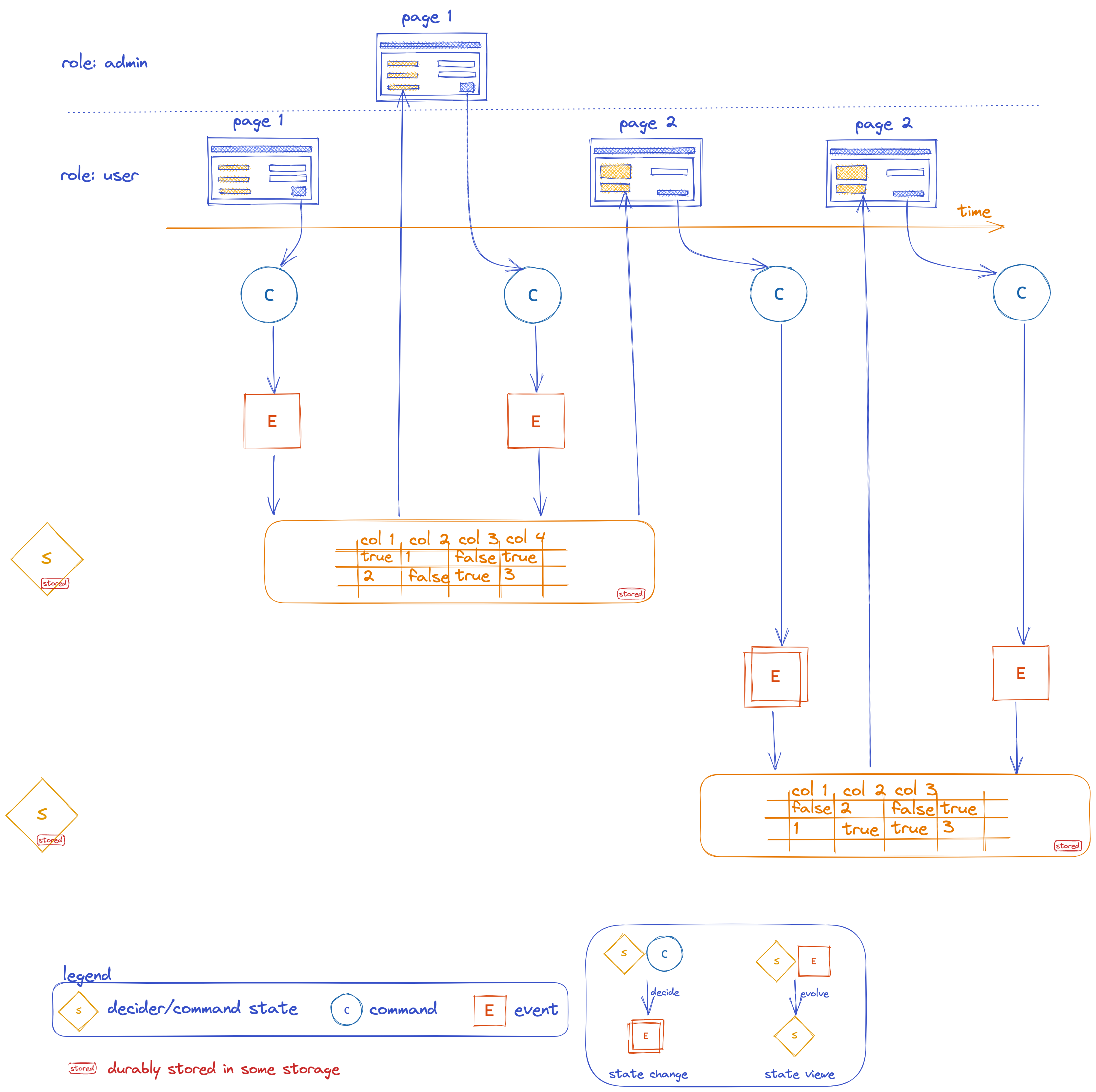Architecture
We learned how to model the domain effectively by using types and functions.
We used decider, view, and saga components from FModel library to model the behavior using pure functions.
- These components do not care about storing or fetching the data.
- They do not produce any side effects of this kind.
- They represent pure computation / pure logics of a program.

Functional Programming emphasizes separating the pure logic of a program (algebras) and the runtime used to run it.
The Application layer
The logic execution will be orchestrated by the outside components (application components) that use the domain
components (decider, view, and saga) to do the computations. These components will be responsible for fetching and
saving the data (suspended effects).

The arrows in the image show the direction of the dependency. Notice that all dependencies point inwards and that Domain does not depend on anybody or anything.
Pushing these decisions from the core domain model is very valuable. Being able to postpone them is a sign of good architecture.
This architectural style is known as Functional Core, Imperative Shell. A bit simplified, it is characterized by two key architectural attributes:
- There is a core with the core business logic, and a shell that handles interactions with the outside world, such as persisting data in databases or providing UIs to interact with end users.
- The shell can call the core, but the core cannot call the shell and the core is even unaware of the existence of the shell. This is also known as the Dependency Rule (see, for example, Clean Architecture to learn more about this rule).
It is similar to Hexagonal Architecture, Ports and Adapters, Clean Architecture, Onion Architecture which have these two attributes in common.
Event-sourced or State-stored systems
The domain model is explicitly modeling events and state, and this opens some interesting options:
- fetch
events, execute domain components/compute, and store neweventsby appending to the previous events in the storage / event-sourced systems / event-stored systems - fetch
state, execute domain components/compute, and store newstateby overwriting the previous state in the storage / traditional / state-stored systems

- Event-Sourced systems are storing the
eventsin immutable storage by only appending. - State-Stored systems are traditional systems that are only storing the current
stateby overwriting the previousstatein the storage.
It is important to realize that your core domain logic does not have to change in order to transit from one flavor to another!
Fmodel exposes couple of types of repository interfaces/ports within the application module to support these two flavors.
- State-stored systems are using single canonical model for writing and reading/presenting, by default.
- Event-stored/Event_sourced systems are split to command and view/query models, by default.
Fmodel is promoting robust event-driven systems only in case of Event-Sourced scenario.
In case of State-Stored scenario, you are limited to Decider and StateStoredAggregate components only. View, MaterializedView, SagaManager components are not available/useful.
- Event-Stored / Event-Sourced
- State-Stored
IEventRepository- responsible for storing and fetching the events of decidersIViewStateRepository- responsible for storing and fetching the state of materialized viewsIActionPublisher- responsible for publishing new actions/commands
IStateRepository- responsible for storing and fetching the state of deciders
You can now compose these repository interfaces with the domain components (decider) in order to implement any of
these options (event-stored or state-stored system):
- Event-Stored / Event-Sourced
- State-Stored
const currentEvents = await this.eventRepository.fetch(command);
const currentState = currentEvents.reduce(
this.decider.evolve,
this.decider.initialState
);
const newEvents = this.decider.decide(command, currentState)
this.eventRepository.save(
newEvents,
command
);
An event-stored system is fetching the events by using the fetchEvents method from the event repository.
It then evolves the state based on the fetched events and delegates the state and the command to the decider component
which will produce new events by executing the decide function.
Finally, the events will be stored via the save function from the event repository.

The implementation of the event repository is not part of the Application layer. It is delegated to the outside
Infrastructure/Adapter layers.
With event-stored approach we are effectively splitting the domain model into
- command model / for writing
- view/query model / for querying
States of both, command model/yellow and view model/green, are evolved out of the same events. This is making a huge difference, as now you have multiple view models independently serving every page/step in the flow with the data it requires, making these steps decoupled.
We are not limited to use a single canonical model for writing and reading/presenting!
View model
The ViewStateRepository can be composed with the view domain component:
const currentState = await this.viewStateRepository.fetch(event);
const newState = this.view.evolve(
currentState? currentState : this.view.initialState,
event
);
this.viewStateRepository.save(newState);
A event-stored system is fetching the current view state by using the fetchState method from
the view state repository.
Finally, the event will fold to the new state by using the view evolve function, and the new state will be stored
via the save function from the view state repository.
The implementation of the view state repository is not part of the Application layer. It is delegated to the outside
Infrastructure/Adapter layers.
const currentState = await this.stateRepository.fetch(command);
const newEvents = this.decider.decide(command, currentState);
const newState = newEvents.reduce(this.decider.evolve, currentState);
this.stateRepository.save(newState);
A state-stored system is fetching the current state by using the fetchState method from the state repository.
It then delegates the command and the current state to the decider which will produce a new list of events by
executing the decide function.
Finally, the list of events will fold to the new state by using the decider evolve function, and the new state will
be stored via the save function from the state repository.

The implementation of the state repository is not part of the Application layer. It is delegated to the outside
Infrastructure/Adapter layers.
State-stored systems are using single canonical model for writing and reading/presenting, by default. The single state is represented with the yellow color on the image.
Fmodel offers application interfaces/components which are actually composed out of side-effects (repository interfaces) and core domain logic (decider, view, saga), providing a default implementation and formalizing the concepts we just described:
- Event-Stored / Event-Sourced
- State-Stored
IEventSourcingAggregateIMaterializedViewISagaManager
IStateStoredAggregate